Clean and disinfect surfaces with this DIY disinfectant spray that makes use of some of the best essential oils for cleaning and disinfecting.
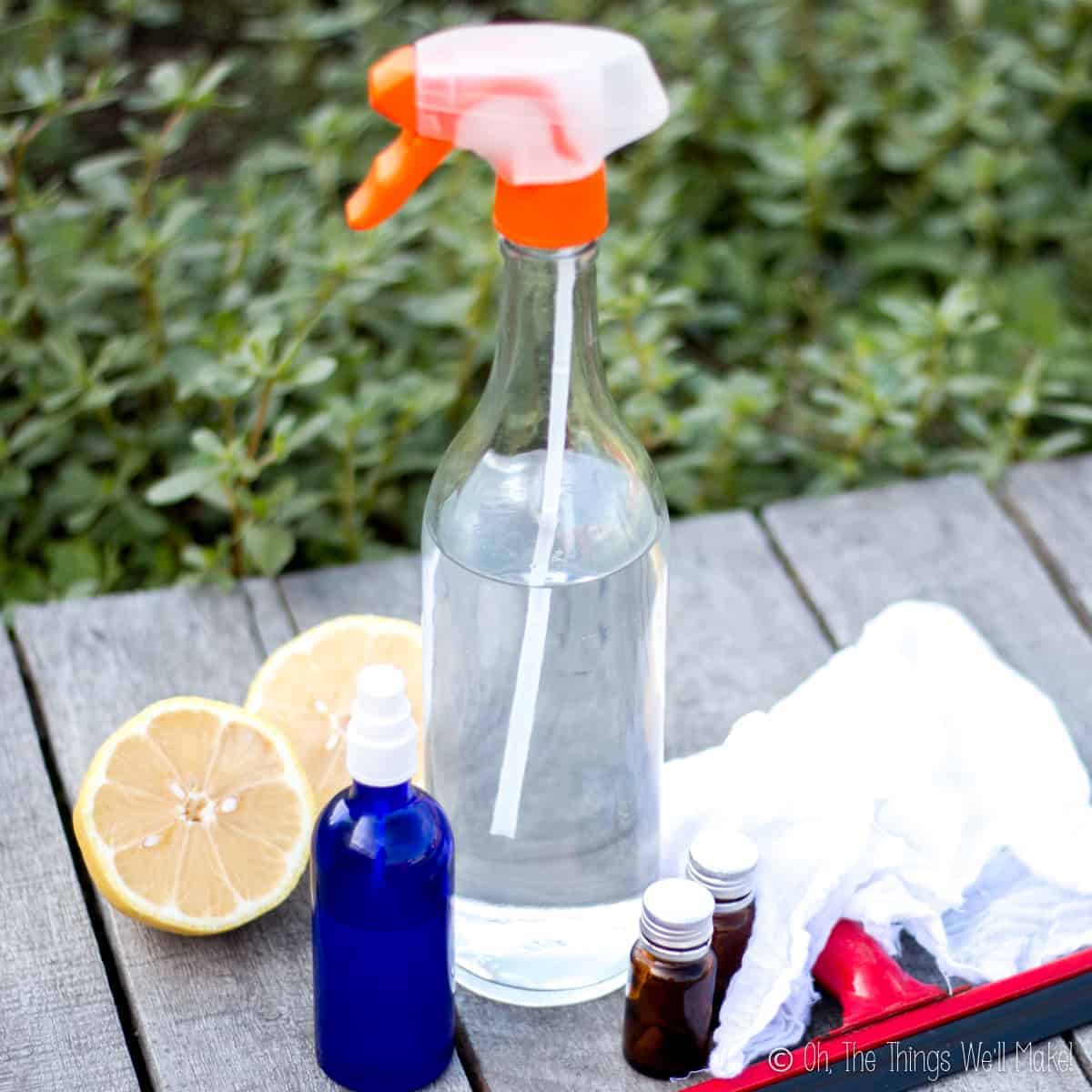
Antimicrobial properties of essential oils
When it comes to making natural cleaning products, essential oils are a great ally. Not only do they add a lovely fragrance, but they also have antimicrobial properties that can help boost the effectiveness of our cleaners and disinfectants.
Essential oils include aldehydes, phenolics, terpenes, and other antimicrobial compounds that make them effective against a variety of pathogens.
Depending on the oil, they can either inhibit bacterial growth or destroy bacterial cells. Some, like sandalwood and vetiver, are more effective against gram-positive bacteria. Others are more effective against gram-negative bacteria. Many (most?) also have antifungal properties.
Pretty much any essential oil has some amount of antimicrobial properties, but some are more popular than others for use in homemade cleaners and disinfectants. Today I’ll concentrate on some of the more popular inexpensive oils that can be used for cleaning and disinfecting.
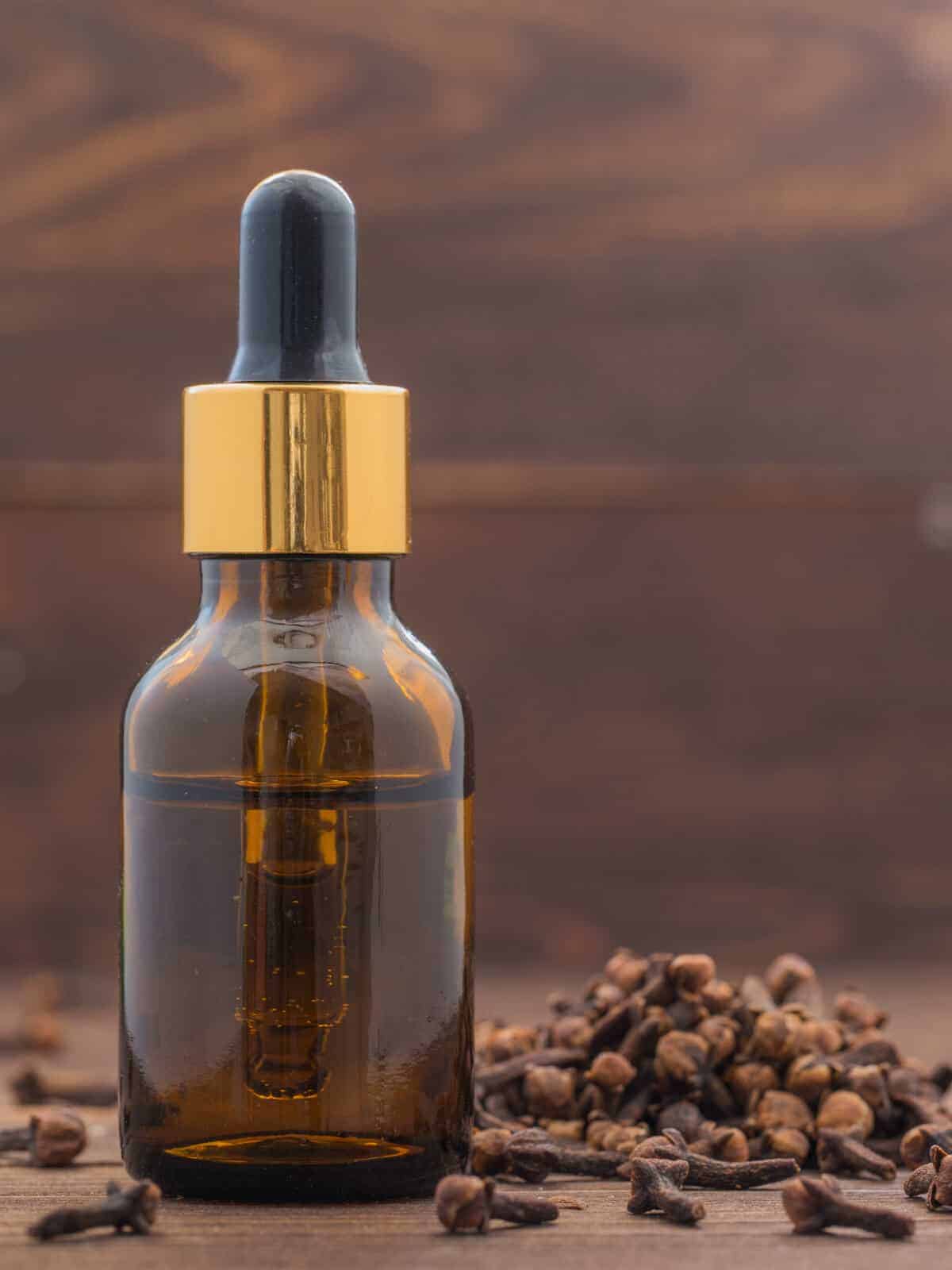
Clove essential oil
Clove essential oil is an effective antibacterial agent. It is between 80 and 95% eugenol, a phenol that interacts with the bacterial cell membrane killing it. Clove essential oil is known to be effective against Salmonella typhi, Staphylococcus aureus, and Pseudomonas aeruginosa.
The eugenol of clove oil is also anti-inflammatory and acts as a mild anesthetic, which is why it is also often used in dental care products. Zinc oxide eugenol is a type of dental cement and temporary filling material.
Clove oil is a great addition to dental care products. You could add it to a homemade toothpaste, homemade tooth powder, and/or a homemade mouthwash.
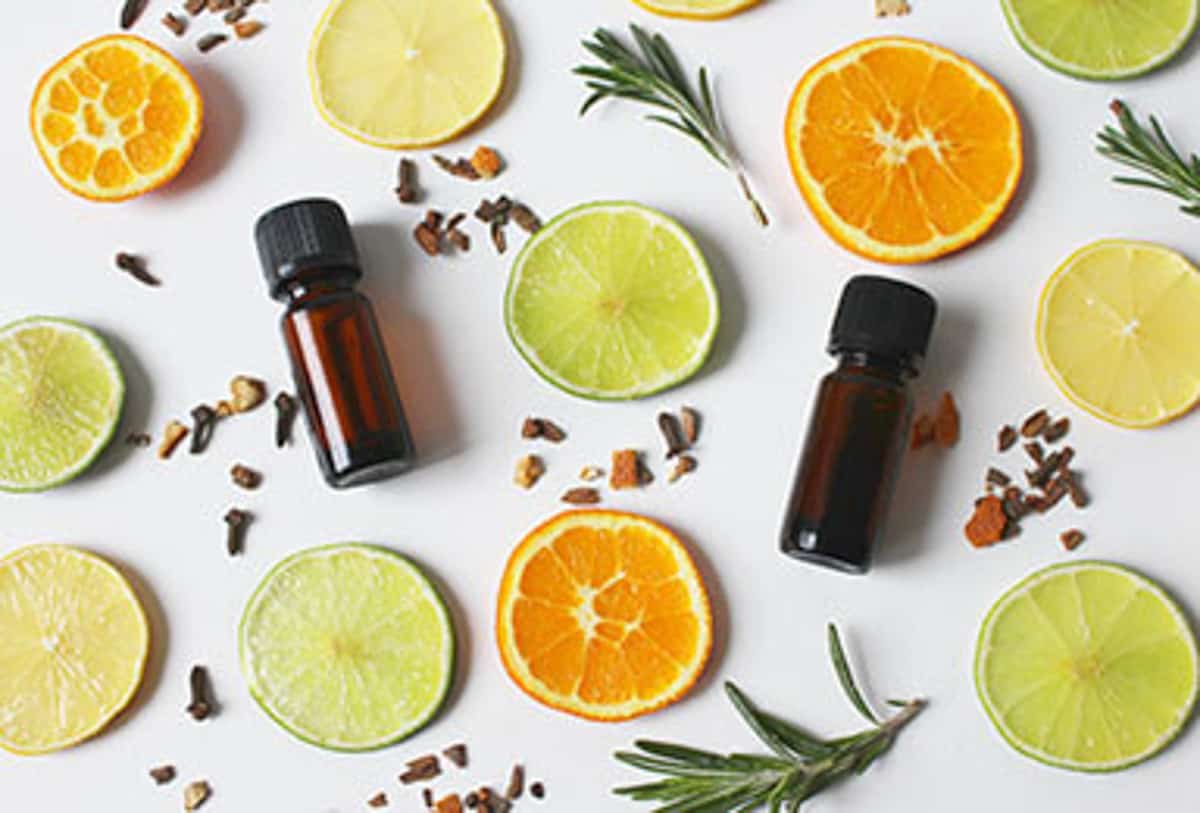
Lemon essential oil
Love the scent of lemons? Lemon essential oil is normally made by cold pressing lemon peels. Other citrus oils like orange oil are made and used in a similar way.
Lemon essential oil is very popular for homemade cosmetics and cleaners, not only because of it’s antibacterial properties. It’s also an inexpensive oil with an uplifting, energizing scent.
- Lemon oil is a great degreaser. I used to use it to help get grease stains out of clothing. (I’ve recently switched to using eucalyptus oil instead, though.)
- It also works wonderfully to remove residual adhesive from stickers and labels.
The scent of lemon essential oil pairs well with many of the other oils, making it a great addition to a homemade cleaner.
Peppermint essential oil
Peppermint essential oil has antibacterial properties against gram-positive and gram-negative bacteria. It’s also antifungal. Plus, it has a lovely and refreshing scent. Because of its refreshing flavor, it’s another oil that is perfect for use in oral care products.
- Use peppermint oil to help disinfect kitchens and bathrooms.
- Peppermint oil is said to deter wasps, spiders, and mice. Add a few drops to cotton balls and place them in areas with pest problems. (Add more oil every few days to renew the scent. (Or add it to a repellent spray.)
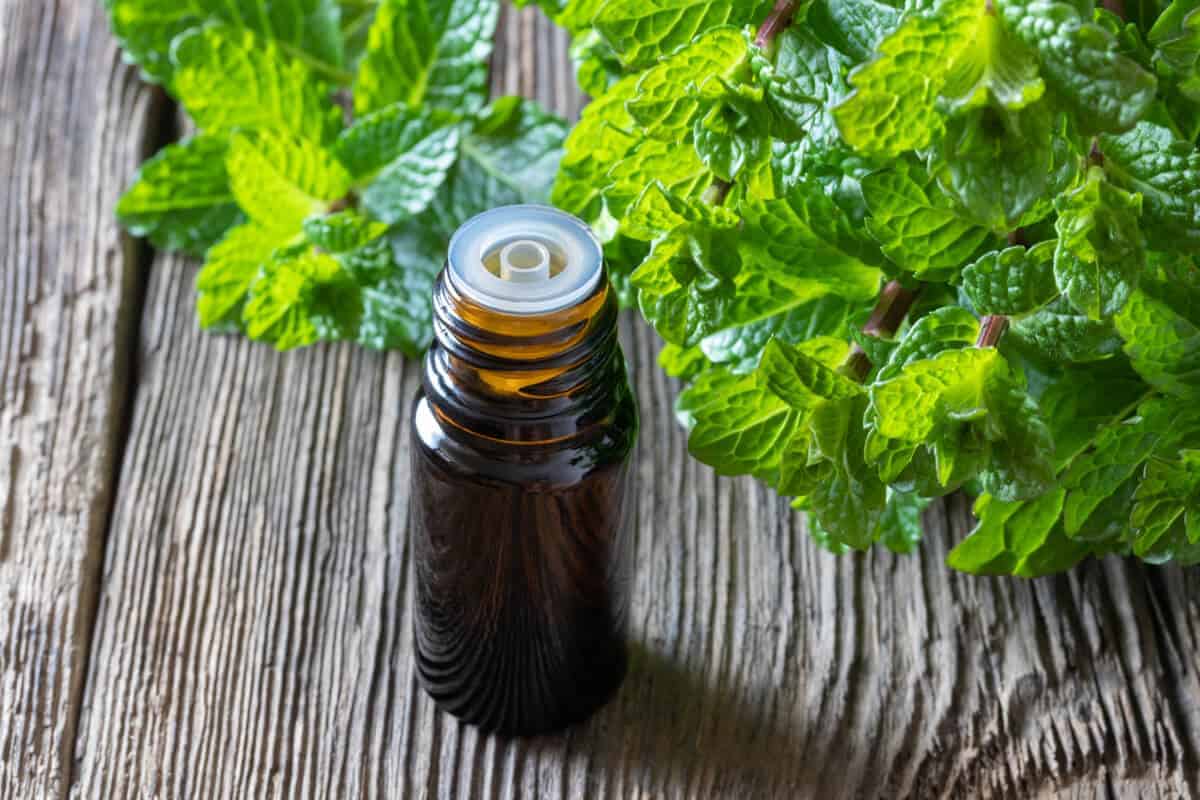
Tea tree essential oil
Because it’s antimicrobial and antiviral, tea-tree oil is an ideal essential oil for your homemade disinfectants.
Tea tree oil comes from the leaves of the Australian Melaleuca tree. Although it is called the “tea tree,” it shouldn’t be confused with the tea leaves we use to make most infusions (or teas). Black, green, and white teas (amongst others) come from the Camellia sinensis plant instead.
A great antifungal, tea tree oil is effective against mold and mildew. It also works well to get rid of musty smells around the home.
Being antiviral, antibacterial, and antifungal, as well as anti-inflammatory, tea tree oil has become one of the most popular essential oils to use in homemade recipes for both home and body.
- Add some tea tree oil and water to a clean spray bottle and spray on mold and mildew around the house (e.g. shower head, faucets). Add vinegar or hydrogen peroxide for a stronger antifungal.
- Remove musty smells from clothes by adding tea tree oil to your laundry detergent.
How to make a disinfectant spray with essential oils
While the antimicrobial properties of essential oils are well known, in order to make a disinfectant spray, we’ll also make use of another antimicrobial, alcohol. Just as alcohol was very important in making an effective hand sanitizer, it’s also very effective as a surface disinfectant.
To be an effective disinfectant against most microbes and viruses, we need to use a minimum of 60% alcohol. 70% is even better.
Materials
- 100g of high proof alcohol (70% or higher)
- 30 drops of essential oils (10 each of lavender, tea tree and lemon)
- Distilled water can optionally be added to 96% alcohol to bring it down to around 70% concentration (Use around 75g alcohol to 25g water.)
- Clean spray bottle
Preparation
Mix together all of the ingredients in a clean spray bottle. Shake the bottle to completely combine the ingredients.
If using 96% alcohol and water, first dissolve the essential oils in the alcohol. Then add the water. The high strength alcohol works as a solubilizer for the oils so that they won’t separate and float on the water. (This works best for 96% alcohol. Lower strength alcohol may not completely solubilize the oils.)
The alcohol also works as a preservative in this recipe. There is no need to add any other preservatives here. (More information about preservatives in my beginner’s guide to natural preservatives.)
Use this natural homemade disinfectant around the home. For best results, use on hard surfaces. Spray the surfaces and then wipe them down with a clean cloth and allow it to dry.
Advice
During the current health scare, we’ve been using this spray to spray down items we’ve brought back from the supermarket before storing them or using them.
Remember that it’s also important to wash reusable shopping bags often. Now, more than ever, consider washing them after each use.
This spray can also be used to sanitize bottles and other containers before using them for your homemade cosmetics.
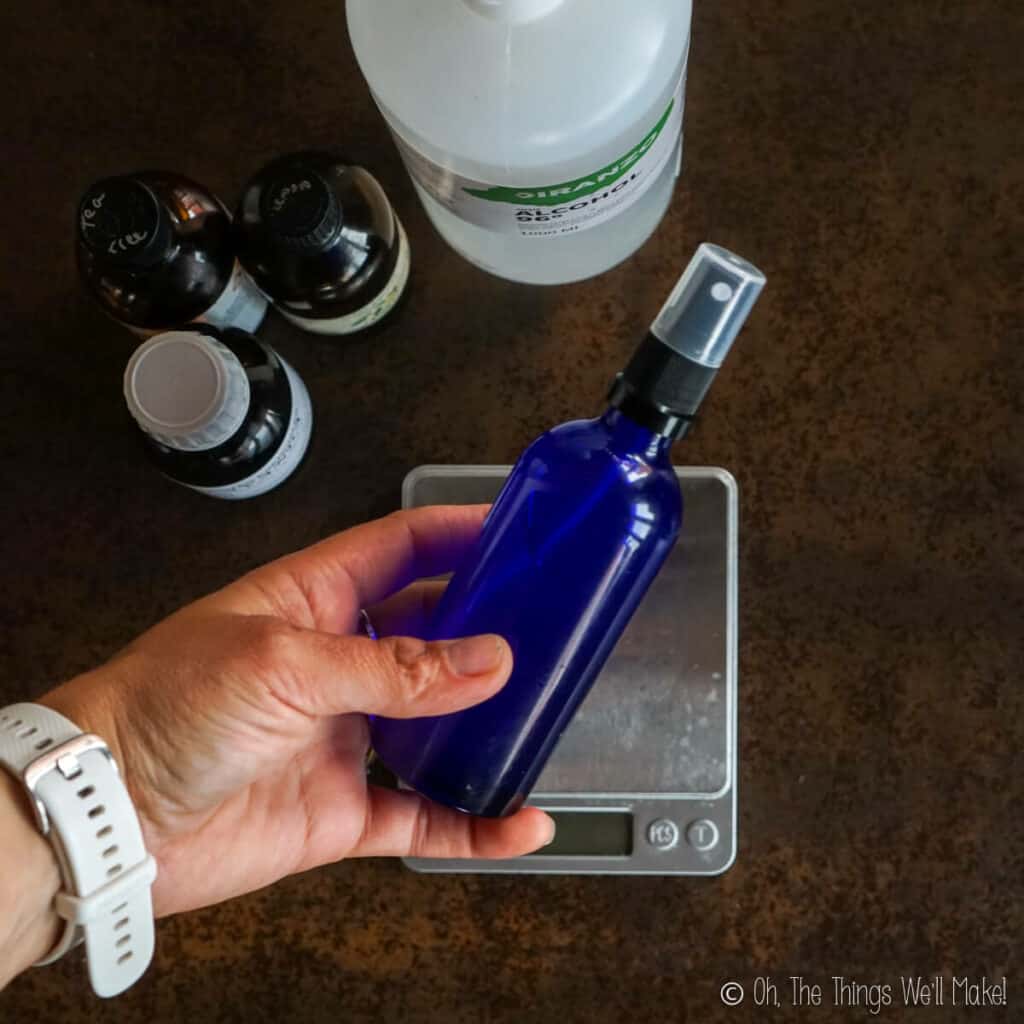
Weigh out and shake ingredients to mix. 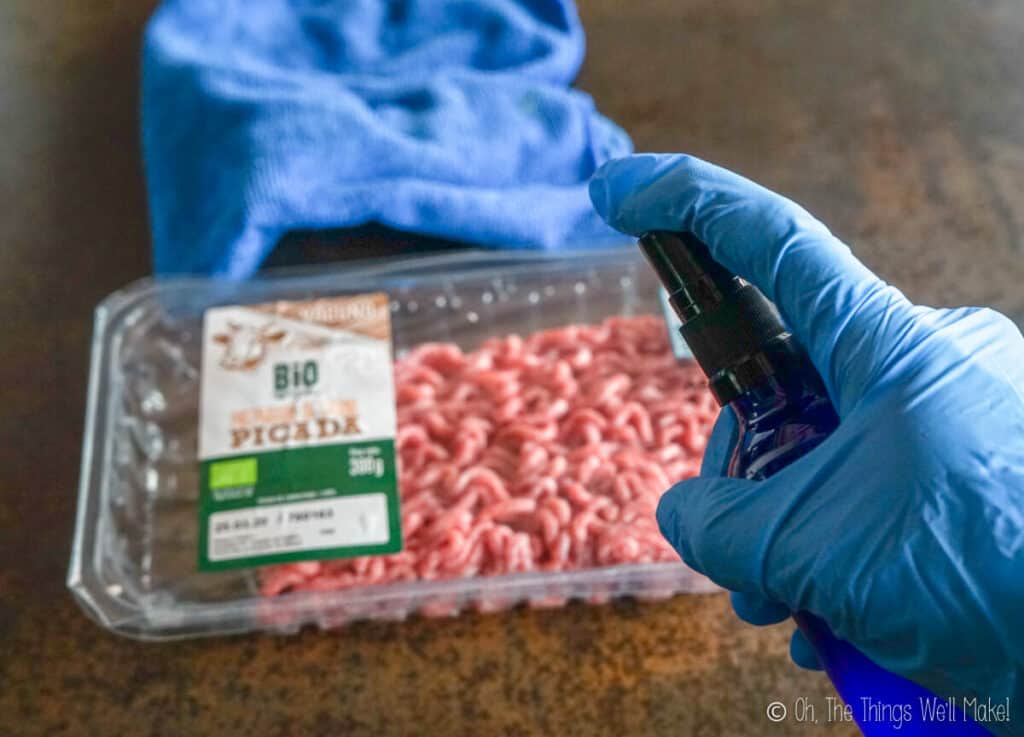
To use: Spray on surfaces and wipe down.
Notes:
You can choose to use one oil or a combination of several oils, depending on what you have on hand. I recommend using less expensive oils like tea tree and lemon for cleaning and saving expensive oils like neroli for skincare or haircare products.
Some metals, like aluminum, can react with certain essential oils (especially strong oils like cinnamon). When it comes to blending or storing essential oils, it’s best to use glass.
Because alcohol is flammable, use this spray in well-ventilated spaces and work on smaller areas at a time. Prolonged and repeated use may cause certain rubbers or plastics to discolor, swell, harden or crack.
Warning for pet owners
Certain essential oils, such as wintergreen, oil of sweet birch, citrus oil (d-limonene), pine oils, Ylang Ylang oil, peppermint oil, cinnamon oil, pennyroyal oil, clove oil, eucalyptus oil, and tea tree oil are said to be toxic to cats.
Some oils are also poisonous for dogs. These include cinnamon, citrus, pennyroyal, peppermint, pine, sweet birch, tea tree (melaleuca), wintergreen, and ylang ylang.
Use extreme caution when using those oils around your pets so that they don’t ingest them.
Video
Disinfectant spray recipe
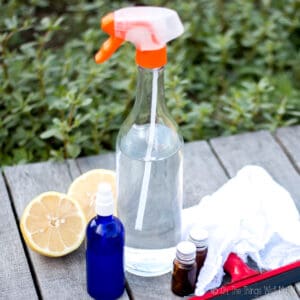
Natural Homemade Disinfectant Spray
Equiment
Materials
- 75 g 96% alcohol
- 25 g distilled water
- 30 drops essential oils 10 drops each of lavender, tea tree and lemon, for example.
Instructions
- Mix together the alcohol and essential oils, shaking or stirring until the oils have dissolved into the alcohol.
- Add water to bring the percentage of alcohol down to around 70%. Mix again to fully combine all of the ingredients.
- Use this natural homemade disinfectant on hard surfaces around the home. Once you spray, wipe down the surface with a cloth and allow it to dry.
Notes
Warning for pet owners:
Certain essential oils, such as wintergreen, oil of sweet birch, citrus oil (d-limonene), pine oils, Ylang Ylang oil, peppermint oil, cinnamon oil, pennyroyal oil, clove oil, eucalyptus oil, and tea tree oil are said to be toxic to cats.Some oils are also poisonous for dogs. These include cinnamon, citrus, pennyroyal, peppermint, pine, sweet birch, tea tree (melaleuca), wintergreen, and ylang ylang.
Use extreme caution when using those oils around your pets so that they don’t ingest them.
If you enjoy making your own cleaning products, why not also try your hand at making your own soap?
This post was originally published on Sept. 21, 2015. It was rewritten in March of 2020 adding more information about the antimicrobial properties of essential oils, adding photos and video, etc.
Related posts
Hand Sanitizer Spray
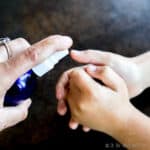
Breathable 3d Face Mask
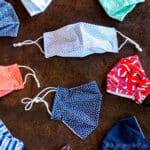
 Español
Español
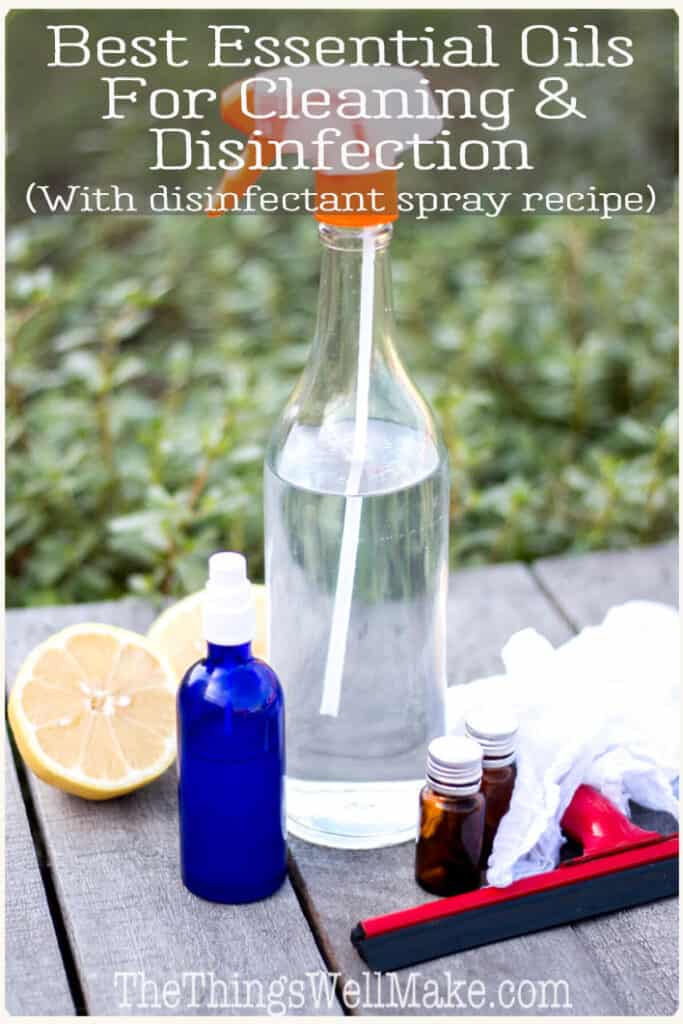
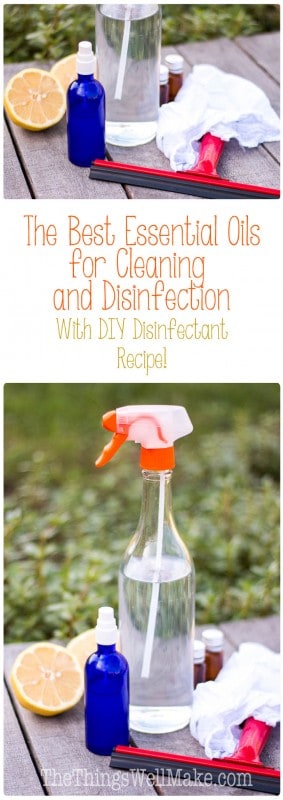
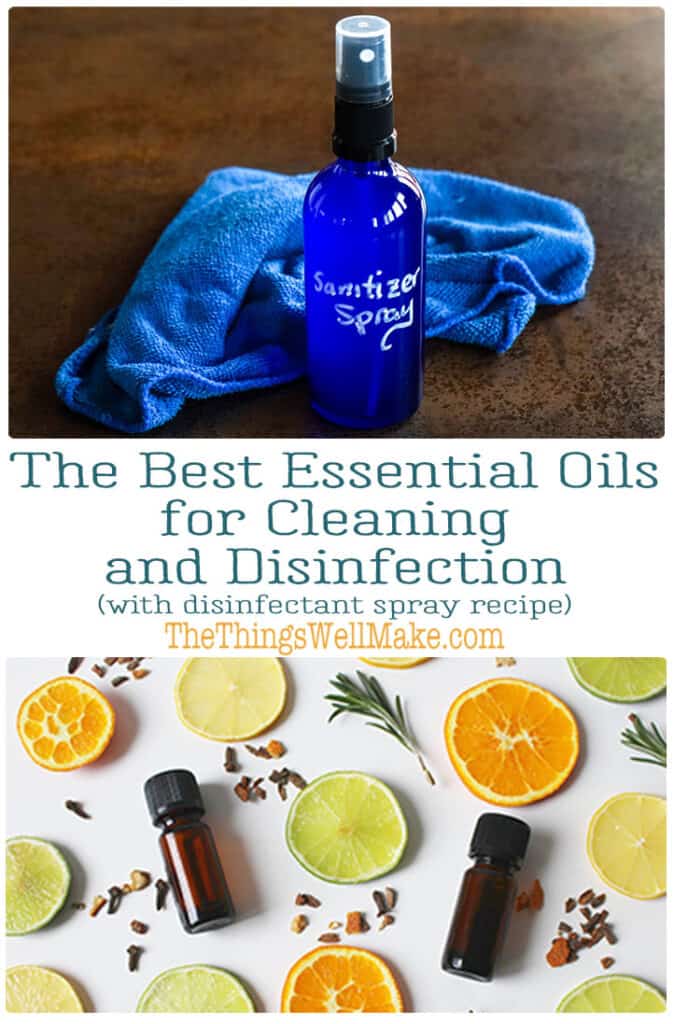
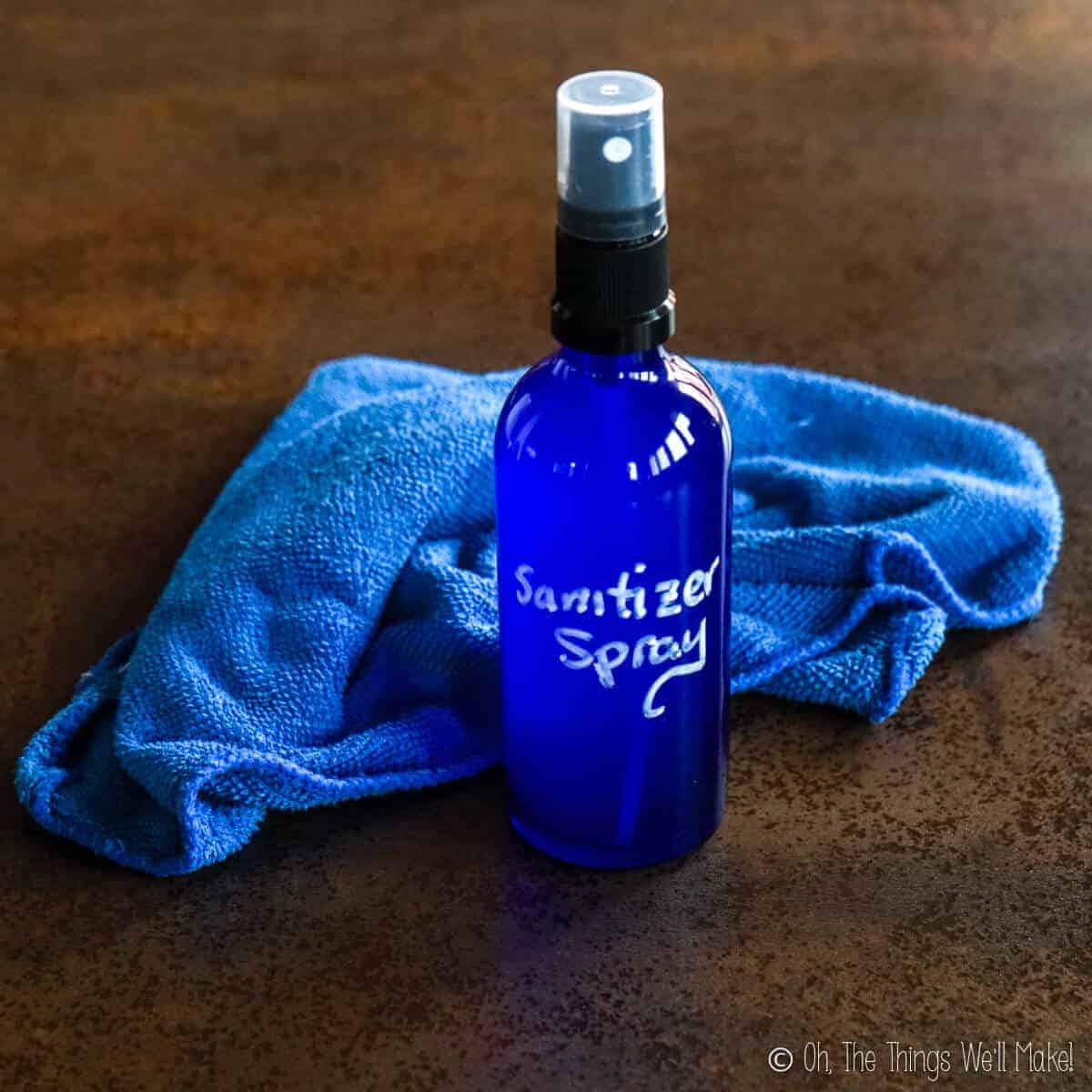
 DIY Hand Sanitizer (That Actually Works!)
DIY Hand Sanitizer (That Actually Works!)
Toza
Cleaners with a high alcohol content can dissolve some paints.
It can look like a mark and then cleaning harder you can remove the paint.
be cautious around painted surfaces until you know that they are safe.
Deborah Adams
I want to use your disinfectant recipe but now I’m afraid too because of my cat! I know she won’t be injecting it but what about the smell?
Also is just plain old hydrogen peroxide okay to use as a disinfectant?
Tracy Ariza, DDS
Theoretically, hydrogen peroxide can also disinfect, but I’m not sure what strength needs to be used for it to be effective.
You could also just use the alcohol without adding any essential oils. 😉
Denise Berger
What would b a good way to incorporate vinegar into this recipe?
Alice
Is there any way to convert grams to cups? I know 75 grams is 2/3 cups, but 25 grams is a little more difficult.
Tracy Ariza, DDS
If it were water, 75g would be .42 US cups. This is alcohol, though, so it will be slightly different.
That said, it’s really not too important. The idea is to use 3 parts alcohol and 1 part water to get a concentration of near 70%. (It will be slightly less than that, so you could use slightly more alcohol or slightly less water, if you want to increase the concentration.)
So, you could use 3/4 cup alcohol and 1/4 cup water.
Robbie
Love your blog. I use essential oils in everything. Love them so much.
Janet
What type of rubbing alcohol (50% 70% 91%) do you use?
Tracy Ariza
Hi Janet,
I normally use 70% because it’s the easiest/cheapest for me to find here.
Fiona
Hi, if i use 96% food grade alcohol, do i still need to add distilled water? Because it’s not easy to find distilled water near where i live. Thanks.
Tracy Ariza, DDS
Hi Fiona,
I just say to add distilled water because it’s microbe-free and without any unwanted substances. I have a water distiller because I make a lot of my own products and it’s best to use distilled to avoid issues. Distilled water is normally sold in the washing detergent aisle or cleaning section of supermarkets as people often use it in their irons to keep minerals from building up inside them.
That said, you should be able to use any filtered water. Perhaps you could pre-boil it to ensure there are no unwanted microbes in it.
While, yes, the alcohol should theoretically kill unwanted microbes in the water, the idea is to keep things as hygienic and sanitized as possible to begin with to ensure that the product will work.
M
What can I use on upholstery for stains and smells?
Tracy Ariza
Hello M,
It would depend on the fabric and the type of stain you are trying to remove. I usually just use liquid soap and water, sometimes mixed with hydrogen peroxide. Baking soda can also help neutralize odors, but can leave behind a residue that lightens up the color of the upholstery, so it may not always be the best choice.
Susie Sandoval
I’m just curious as to what oils would be bad to have my small dogs around . I would like to start using peppermint oil in my mop water, is tea tree oil bad for dogs?
Tracy Ariza
Hi Susie,
From what I’ve read, tea tree is generally safe for dogs. Peppermint can be toxic to dogs, though. That said, that’s more in referring to using it on them and in their food. I think it’s generally safe to use either in the mop water.
Tess
Hi Tracy,
Might you have a recipe I can make for travelling on airplanes?
Thanks so much!
Tracy Ariza
What type of recipe are you looking for?
I just posted how to make your own shampoo bar and a DIY conditioner bar. (But you posted this comment on a post about cleaning, so I’m not sure what you’re seeking.) 😉
Christopher Coles
Lemon essential oil is amazing! I really love and appreciate your tips! Thanks for sharing!
Tracy Ariza
I agree! Glad you enjoyed it.